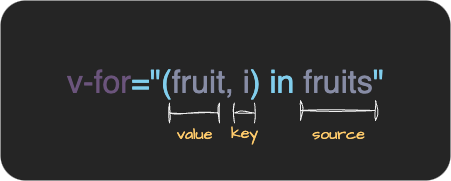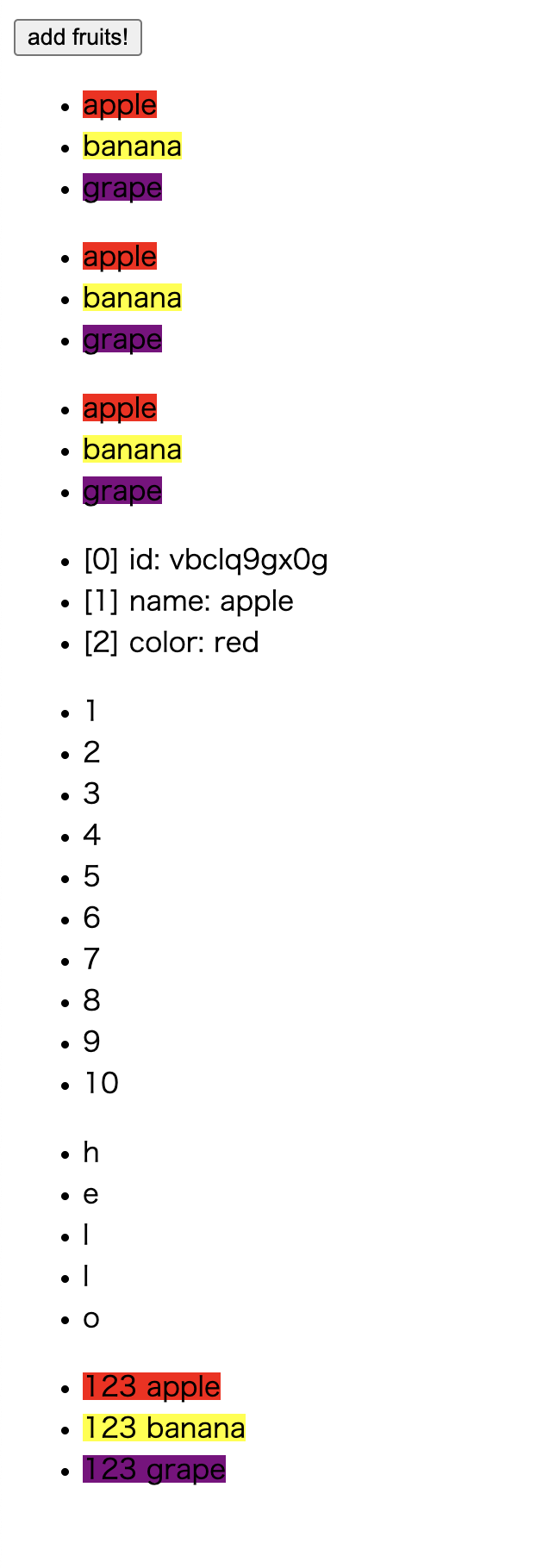支援 v-for 指令
目標開發者介面
現在,讓我們繼續指令的實現.這次,讓我們嘗試支援 v-for.
嗯,我想對於那些之前使用過 Vue.js 的人來說,這是一個熟悉的指令.
v-for 有各種語法. 最基本的是循環遍歷陣列,但你也可以循環遍歷其他東西,如字串,物件鍵,範圍等等.
https://vuejs.org/v2/guide/list.html
雖然有點長,但這次,讓我們以以下開發者介面為目標:
<script>
import { createApp, defineComponent, ref } from 'chibivue'
const genId = () => Math.random().toString(36).slice(2)
const FRUITS_FACTORIES = [
() => ({ id: genId(), name: 'apple', color: 'red' }),
() => ({ id: genId(), name: 'banana', color: 'yellow' }),
() => ({ id: genId(), name: 'grape', color: 'purple' }),
]
export default {
setup() {
const fruits = ref([...FRUITS_FACTORIES].map(f => f()))
const addFruit = () => {
fruits.value.push(
FRUITS_FACTORIES[Math.floor(Math.random() * FRUITS_FACTORIES.length)](),
)
}
return { fruits, addFruit }
},
}
</script>
<template>
<button @click="addFruit">add fruits!</button>
<!-- basic -->
<ul>
<li v-for="fruit in fruits" :key="fruit.id">
<span :style="{ backgroundColor: fruit.color }">{{ fruit.name }}</span>
</li>
</ul>
<!-- indexed -->
<ul>
<li v-for="(fruit, i) in fruits" :key="fruit.id">
<span :style="{ backgroundColor: fruit.color }">{{ fruit.name }}</span>
</li>
</ul>
<!-- destructuring -->
<ul>
<li v-for="({ id, name, color }, i) in fruits" :key="id">
<span :style="{ backgroundColor: color }">{{ name }}</span>
</li>
</ul>
<!-- object -->
<ul>
<li v-for="(value, key, idx) in fruits[0]" :key="key">
[{{ idx }}] {{ key }}: {{ value }}
</li>
</ul>
<!-- range -->
<ul>
<li v-for="n in 10">{{ n }}</li>
</ul>
<!-- string -->
<ul>
<li v-for="c in 'hello'">{{ c }}</li>
</ul>
<!-- nested -->
<ul>
<li v-for="({ id, name, color }, i) in fruits" :key="id">
<span :style="{ backgroundColor: color }">
<span v-for="n in 3">{{ n }}</span>
<span>{{ name }}</span>
</span>
</li>
</ul>
</template>你可能會想,"我們突然要實現這麼多東西?這不可能!"但不要擔心,我會一步一步地解釋.
實現方法
首先,讓我們大致思考一下我們想要如何編譯它,並考慮在實現時可能遇到的困難點.
首先,讓我們看看期望的編譯結果.
基本結構並不那麼困難.我們將在 runtime-core 中實現一個名為 renderList 的輔助函式來渲染列表,並將其編譯為表達式.
示例 1:
<!-- input -->
<li v-for="fruit in fruits" :key="fruit.id">{{ fruit.name }}</li>// output
h(
_Fragment,
null,
_renderList(fruits, fruit => h('li', { key: fruit.id }, fruit.name)),
)示例 2:
<!-- input -->
<li v-for="(fruit, idx) in fruits" :key="fruit.id">
{{ idx }}: {{ fruit.name }}
</li>// output
h(
_Fragment,
null,
_renderList(fruits, fruit => h('li', { key: fruit.id }, fruit.name)),
)示例 3:
<!-- input -->
<li v-for="{ name, id } in fruits" :key="id">{{ name }}</li>// output
h(
_Fragment,
null,
_renderList(fruits, ({ name, id }) => h('li', { key: id }, name)),
)將來,作為 renderList 第一個參數傳遞的值預期不僅是陣列,還可能是數字和物件.但是,現在讓我們假設只期望陣列._renderList 函式本身的實現可以理解為類似於 Array.prototype.map 的東西.至於除陣列之外的值,你只需要在 _renderList 中對它們進行規範化,所以現在讓我們忘記它們(只關注陣列).
現在,對於那些到目前為止已經實現了各種指令的人來說,實現這種編譯器(轉換器)應該不會太困難.
關鍵實現點(困難點)
困難點在於在 SFC(單檔案組件)中使用它時.你還記得在 SFC 中使用的編譯器和在瀏覽器中使用的編譯器之間的區別嗎?是的,就是使用 _ctx 解析表達式.
在 v-for 中,使用者定義的局部變數以各種形式出現,所以你需要正確地收集它們並跳過 rewriteIdentifiers.
// 錯誤示例
h(
_Fragment,
null,
_renderList(
_ctx.fruits, // fruits 有前綴是可以的,因為它是從 _ctx 綁定的
({ name, id }) =>
h(
'li',
{ key: _ctx.id }, // 這裡有 _ctx 是不對的
_ctx.name, // 這裡有 _ctx 是不對的
),
),
)// 正確示例
h(
_Fragment,
null,
_renderList(
_ctx.fruits, // fruits 有前綴是可以的,因為它是從 _ctx 綁定的
({ name, id }) =>
h(
'li',
{ key: id }, // 這裡不應該有 _ctx
name, // 這裡不應該有 _ctx
),
),
)從示例 1 到 3,有各種局部變數的定義.
你需要分析每個定義並收集要跳過的識別符.
現在,讓我們暫時擱置如何實現這一點,從大局開始實現.
AST 的實現
現在,讓我們像往常一樣定義 AST.
與 v-if 一樣,我們將考慮轉換後的 AST(無需實現解析器).
export const enum NodeTypes {
// .
// .
FOR,
// .
// .
JS_FUNCTION_EXPRESSION,
}
export type ParentNode =
| RootNode
| ElementNode
| ForNode
| IfBranchNode
export interface ForNode extends Node {
type: NodeTypes.FOR
source: ExpressionNode
valueAlias: ExpressionNode | undefined
keyAlias: ExpressionNode | undefined
children: TemplateChildNode[]
parseResult: ForParseResult // 稍後解釋
codegenNode?: ForCodegenNode
}
export interface ForCodegenNode extends VNodeCall {
isBlock: true
tag: typeof FRAGMENT
props: undefined
children: ForRenderListExpression
}
export interface ForRenderListExpression extends CallExpression {
callee: typeof RENDER_LIST // 稍後解釋
arguments: [ExpressionNode, ForIteratorExpression]
}
// 還支援函式表達式,因為回呼函式用作 renderList 的第二個參數。
export interface FunctionExpression extends Node {
type: NodeTypes.JS_FUNCTION_EXPRESSION
params: ExpressionNode | string | (ExpressionNode | string)[] | undefined
returns?: TemplateChildNode | TemplateChildNode[] | JSChildNode
newline: boolean
}
// 在 v-for 的情況下,返回是固定的,所以它被表示為專門用於此目的的 AST。
export interface ForIteratorExpression extends FunctionExpression {
returns: VNodeCall
}
export type JSChildNode =
| VNodeCall
| CallExpression
| ObjectExpression
| ArrayExpression
| ConditionalExpression
| ExpressionNode
| FunctionExpression關於 RENDER_LIST,像往常一樣,將其添加到 runtimeHelpers.
// runtimeHelpers.ts
// .
// .
// .
export const RENDER_LIST = Symbol()
export const helperNameMap: Record<symbol, string> = {
// .
// .
[RENDER_LIST]: `renderList`,
// .
// .
}至於 ForParseResult,其定義在 transform/vFor 中.
export interface ForParseResult {
source: ExpressionNode
value: ExpressionNode | undefined
key: ExpressionNode | undefined
index: ExpressionNode | undefined
}為了解釋它們各自指的是什麼,
在 v-for="(fruit, i) in fruits" 的情況下,
- source:
fruits - value:
fruit - key:
i - index:
undefined
index 是將物件應用於 v-for 時的第三個參數.
https://vuejs.org/v2/guide/list.html#v-for-with-an-object

關於 value,如果你使用像 { id, name, color, } 這樣的解構賦值,它將有多個識別符.
我們收集由 value,key 和 index 定義的識別符,並跳過添加前綴.
codegen 的實現
雖然順序有點顛倒,但讓我們先實現 codegen,因為沒有太多要討論的. 只需要做兩件事:處理 NodeTypes.FOR 和函式表達式的 codegen(這是第一次出現).
switch (node.type) {
case NodeTypes.ELEMENT:
case NodeTypes.FOR:
case NodeTypes.IF:
// .
// .
// .
case NodeTypes.JS_FUNCTION_EXPRESSION:
genFunctionExpression(node, context, option)
break
// .
// .
// .
}
function genFunctionExpression(
node: FunctionExpression,
context: CodegenContext,
option: CompilerOptions,
) {
const { push, indent, deindent } = context
const { params, returns, newline } = node
push(`(`, node)
if (isArray(params)) {
genNodeList(params, context, option)
} else if (params) {
genNode(params, context, option)
}
push(`) => `)
if (newline) {
push(`{`)
indent()
}
if (returns) {
if (newline) {
push(`return `)
}
if (isArray(returns)) {
genNodeListAsArray(returns, context, option)
} else {
genNode(returns, context, option)
}
}
if (newline) {
deindent()
push(`}`)
}
}沒有什麼特別困難的.就這樣結束了.
轉換器的實現
準備工作
在實現轉換器之前,還有一些準備工作.
正如我們在 v-on 中所做的,在 v-for 的情況下,執行 processExpression 的時機有點特殊(我們需要收集局部變數),所以我們在 transformExpression 中跳過它.
export const transformExpression: NodeTransform = (node, ctx) => {
if (node.type === NodeTypes.INTERPOLATION) {
node.content = processExpression(node.content as SimpleExpressionNode, ctx)
} else if (node.type === NodeTypes.ELEMENT) {
for (let i = 0; i < node.props.length; i++) {
const dir = node.props[i]
if (
dir.type === NodeTypes.DIRECTIVE &&
dir.name !== 'for'
) {
// .
// .
// .
}
}
}
}收集識別符
現在,在我們繼續主要實現之前,讓我們思考如何收集識別符.
這次,我們需要考慮不僅是像 fruit 這樣的簡單識別符,還有像 { id, name, color } 這樣的解構賦值. 為此,似乎我們需要像往常一樣使用 TreeWalker.
目前,在 processExpression 函式中,實現是搜尋識別符並向它們添加 _ctx.但是,這次我們只需要收集識別符而不添加任何東西.讓我們實現這一點.
首先,讓我們準備一個地方來存儲收集的識別符.由於如果每個 Node 都有它們對於 codegen 和其他目的會很方便,讓我們向 AST 添加一個可以在每個 Node 上保存多個識別符的屬性.
目標是 CompoundExpressionNode 和 SimpleExpressionNode.
像 fruit 這樣的簡單識別符將被添加到 SimpleExpressionNode, 像 { id, name, color } 這樣的解構賦值將被添加到 CompoundExpressionNode.(在視覺化方面,它將是一個複合表達式,如 ["{", simpleExpr("id"), ",", simpleExpr("name"), ",", simpleExpr("color"), "}"])
export interface SimpleExpressionNode extends Node {
type: NodeTypes.SIMPLE_EXPRESSION
content: string
isStatic: boolean
identifiers?: string[]
}
export interface CompoundExpressionNode extends Node {
type: NodeTypes.COMPOUND_EXPRESSION
children: (
| SimpleExpressionNode
| CompoundExpressionNode
| InterpolationNode
| TextNode
| string
)[]
identifiers?: string[]
}在 processExpression 函式中,讓我們在這裡實現收集識別符的邏輯,並透過將收集的識別符添加到轉換器的上下文中來跳過添加前綴.
目前,用於添加/刪除識別符的函式被配置為接收單個識別符作為字串,所以讓我們將其更改為假設 { identifier: string[] } 的形式.
export interface TransformContext extends Required<TransformOptions> {
// .
// .
// .
addIdentifiers(exp: ExpressionNode | string): void
removeIdentifiers(exp: ExpressionNode | string): void
// .
// .
// .
}
const context: TransformContext = {
// .
// .
// .
addIdentifiers(exp) {
if (!isBrowser) {
if (isString(exp)) {
addId(exp)
} else if (exp.identifiers) {
exp.identifiers.forEach(addId)
} else if (exp.type === NodeTypes.SIMPLE_EXPRESSION) {
addId(exp.content)
}
}
},
removeIdentifiers(exp) {
if (!isBrowser) {
if (isString(exp)) {
removeId(exp)
} else if (exp.identifiers) {
exp.identifiers.forEach(removeId)
} else if (exp.type === NodeTypes.SIMPLE_EXPRESSION) {
removeId(exp.content)
}
}
},
// .
// .
// .
}現在,讓我們在 processExpression 函式中實現收集識別符的邏輯.
在 processExpression 函式中,定義一個名為 asParams 的選項,如果設置為 true,實現跳過添加前綴並在 node.identifiers 中收集識別符的邏輯.
asParams 旨在引用在 renderList 的回呼函式中定義的參數(局部變數).
export function processExpression(
node: SimpleExpressionNode,
ctx: TransformContext,
asParams = false,
) {
// .
if (isSimpleIdentifier(rawExp)) {
const isScopeVarReference = ctx.identifiers[rawExp]
if (
!asParams &&
!isScopeVarReference
) {
node.content = rewriteIdentifier(rawExp)
}
return node
// .
}
}這就是簡單識別符的結束.問題在於其他情況.
為此,我們將使用在 babelUtils 中實現的 walkIdentifiers.
由於我們假設定義為函式參數的局部變數,我們將在此函式中將它們轉換為"函式參數",並在 walkIdentifier 中將它們作為 Function params 搜尋.
// 將 asParams 轉換為類似函式參數的形式
const source = `(${rawExp})${asParams ? `=>{}` : ``}`
// walkIdentifiers 稍微複雜一些。
export function walkIdentifiers(
root: Node,
onIdentifier: (node: Identifier) => void,
knownIds: Record<string, number> = Object.create(null),
parentStack: Node[] = [],
) {
// .
;(walk as any)(root, {
// prettier-ignore
enter(node: Node, parent: Node | undefined) {
parent && parentStack.push(parent);
if (node.type === "Identifier") {
const isLocal = !!knownIds[node.name];
const isRefed = isReferencedIdentifier(node, parent!, parentStack);
if (!isLocal && isRefed) {
onIdentifier(node);
}
} else if (isFunctionType(node)) {
// 稍後解釋(在此函式內的 knownIds 中收集識別符)
walkFunctionParams(node, (id) =>
markScopeIdentifier(node, id, knownIds)
);
}
},
})
}
export const isFunctionType = (node: Node): node is Function => {
return /Function(?:Expression|Declaration)$|Method$/.test(node.type)
}我們在這裡做的只是如果 node 是函式則遍歷參數,並將識別符收集到 identifiers 中.
在 walkIdentifiers 的呼叫者中,我們定義 knownIds 並將其與 knownIds 一起傳遞給 walkIdentifiers 以收集識別符.
在 walkIdentifiers 中收集後,最後,在生成 CompoundExpression 時基於 knownIds 生成識別符.
const knownIds: Record<string, number> = Object.create(ctx.identifiers)
walkIdentifiers(
ast,
node => {
node.name = rewriteIdentifier(node.name)
ids.push(node as QualifiedId)
},
knownIds, // 傳遞
parentStack,
)
// .
// .
// .
ret.identifiers = Object.keys(knownIds) // 基於 knownIds 生成識別符
return ret雖然檔案有點亂序,但 walkFunctionParams 和 markScopeIdentifier 只是遍歷參數並將 Node.name 添加到 knownIds.
export function walkFunctionParams(
node: Function,
onIdent: (id: Identifier) => void,
) {
for (const p of node.params) {
for (const id of extractIdentifiers(p)) {
onIdent(id)
}
}
}
function markScopeIdentifier(
node: Node & { scopeIds?: Set<string> },
child: Identifier,
knownIds: Record<string, number>,
) {
const { name } = child
if (node.scopeIds && node.scopeIds.has(name)) {
return
}
if (name in knownIds) {
knownIds[name]++
} else {
knownIds[name] = 1
}
;(node.scopeIds || (node.scopeIds = new Set())).add(name)
}有了這個,我們應該能夠收集識別符.讓我們使用這個實現 transformFor 並完成 v-for 指令!
transformFor
現在我們已經克服了障礙,讓我們像往常一樣使用我們擁有的東西實現轉換器. 還有一點點,讓我們加油!
像 v-if 一樣,這也涉及結構,所以讓我們使用 createStructuralDirectiveTransform 來實現它.
我認為如果我用程式碼寫解釋會更容易理解,所以我將在下面提供帶有解釋的程式碼.但是,請在查看這個之前嘗試透過閱讀原始碼自己實現它!
// 這是主要結構的實現,類似於 v-if。
// 它在適當的地方執行 processFor 並在適當的地方生成 codegenNode。
// processFor 是最複雜的實現。
export const transformFor = createStructuralDirectiveTransform(
'for',
(node, dir, context) => {
return processFor(node, dir, context, forNode => {
// 如預期的那樣,生成呼叫 renderList 的程式碼。
const renderExp = createCallExpression(context.helper(RENDER_LIST), [
forNode.source,
]) as ForRenderListExpression
// 為作為 v-for 容器的 Fragment 生成 codegenNode。
forNode.codegenNode = createVNodeCall(
context,
context.helper(FRAGMENT),
undefined,
renderExp,
) as ForCodegenNode
// codegen 過程(在 processFor 中的解析和識別符收集之後執行)
return () => {
const { children } = forNode
const childBlock = (children[0] as ElementNode).codegenNode as VNodeCall
renderExp.arguments.push(
createFunctionExpression(
createForLoopParams(forNode.parseResult),
childBlock,
true /* force newline */,
) as ForIteratorExpression,
)
}
})
},
)
export function processFor(
node: ElementNode,
dir: DirectiveNode,
context: TransformContext,
processCodegen?: (forNode: ForNode) => (() => void) | undefined,
) {
// 解析 v-for 的表達式。
// 在 parseResult 階段,每個 Node 的識別符已經被收集。
const parseResult = parseForExpression(
dir.exp as SimpleExpressionNode,
context,
)
const { addIdentifiers, removeIdentifiers } = context
const { source, value, key, index } = parseResult!
const forNode: ForNode = {
type: NodeTypes.FOR,
loc: dir.loc,
source,
valueAlias: value,
keyAlias: key,
parseResult: parseResult!,
children: [node],
}
// 用 forNode 替換 Node。
context.replaceNode(forNode)
if (!context.isBrowser) {
// 將收集的識別符添加到上下文中。
value && addIdentifiers(value)
key && addIdentifiers(key)
index && addIdentifiers(index)
}
// 生成程式碼(這允許跳過向局部變數添加前綴)
const onExit = processCodegen && processCodegen(forNode)
return () => {
value && removeIdentifiers(value)
key && removeIdentifiers(key)
index && removeIdentifiers(index)
if (onExit) onExit()
}
}
// 使用正規表達式解析給定給 v-for 的表達式。
const forAliasRE = /([\s\S]*?)\s+(?:in|of)\s+([\s\S]*)/
const forIteratorRE = /,([^,\}\]]*)(?:,([^,\}\]]*))?$/
const stripParensRE = /^\(|\)$/g
export interface ForParseResult {
source: ExpressionNode
value: ExpressionNode | undefined
key: ExpressionNode | undefined
index: ExpressionNode | undefined
}
export function parseForExpression(
input: SimpleExpressionNode,
context: TransformContext,
): ForParseResult | undefined {
const loc = input.loc
const exp = input.content
const inMatch = exp.match(forAliasRE)
if (!inMatch) return
const [, LHS, RHS] = inMatch
const result: ForParseResult = {
source: createAliasExpression(
loc,
RHS.trim(),
exp.indexOf(RHS, LHS.length),
),
value: undefined,
key: undefined,
index: undefined,
}
if (!context.isBrowser) {
result.source = processExpression(
result.source as SimpleExpressionNode,
context,
)
}
let valueContent = LHS.trim().replace(stripParensRE, '').trim()
const iteratorMatch = valueContent.match(forIteratorRE)
const trimmedOffset = LHS.indexOf(valueContent)
if (iteratorMatch) {
valueContent = valueContent.replace(forIteratorRE, '').trim()
const keyContent = iteratorMatch[1].trim()
let keyOffset: number | undefined
if (keyContent) {
keyOffset = exp.indexOf(keyContent, trimmedOffset + valueContent.length)
result.key = createAliasExpression(loc, keyContent, keyOffset)
if (!context.isBrowser) {
// 如果不在瀏覽器模式下,將 asParams 設置為 true 並收集 key 的識別符。
result.key = processExpression(result.key, context, true)
}
}
if (iteratorMatch[2]) {
const indexContent = iteratorMatch[2].trim()
if (indexContent) {
result.index = createAliasExpression(
loc,
indexContent,
exp.indexOf(
indexContent,
result.key
? keyOffset! + keyContent.length
: trimmedOffset + valueContent.length,
),
)
if (!context.isBrowser) {
// 如果不在瀏覽器模式下,將 asParams 設置為 true 並收集 index 的識別符。
result.index = processExpression(result.index, context, true)
}
}
}
}
if (valueContent) {
result.value = createAliasExpression(loc, valueContent, trimmedOffset)
if (!context.isBrowser) {
// 如果不在瀏覽器模式下,將 asParams 設置為 true 並收集 value 的識別符。
result.value = processExpression(result.value, context, true)
}
}
return result
}
function createAliasExpression(
range: SourceLocation,
content: string,
offset: number,
): SimpleExpressionNode {
return createSimpleExpression(
content,
false,
getInnerRange(range, offset, content.length),
)
}
export function createForLoopParams(
{ value, key, index }: ForParseResult,
memoArgs: ExpressionNode[] = [],
): ExpressionNode[] {
return createParamsList([value, key, index, ...memoArgs])
}
function createParamsList(
args: (ExpressionNode | undefined)[],
): ExpressionNode[] {
let i = args.length
while (i--) {
if (args[i]) break
}
return args
.slice(0, i + 1)
.map((arg, i) => arg || createSimpleExpression(`_`.repeat(i + 1), false))
}現在,剩下的部分是實際包含在編譯程式碼中的 renderList 的實現,以及註冊轉換器的實現.如果我們能實現這些,v-for 應該就能工作了!
讓我們嘗試執行它!

看起來進展順利.
到此為止的原始碼:GitHub
